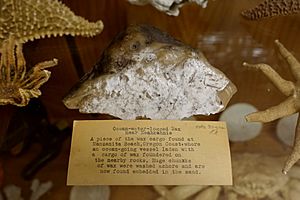Beeswax wreck facts for kids
The Beeswax Wreck is a famous shipwreck found off the coast of Oregon. It was discovered by Craig Andes near Cape Falcon in 2013. This ship is believed to be a Spanish Manila galleon that sank in 1693. It was carrying a huge amount of beeswax. Chunks of this beeswax have been washing up on Oregon's north coast for over 200 years!
In 2019, fisherman Craig Andes found large wooden beams inside caves north of Manzanita. He believed these were from the lost ship. Experts were unsure at first. However, tests later showed the wood was indeed part of the Santo Cristo de Burgos shipwreck. This Spanish galleon left Manila in 1693. It carried valuable items like porcelain, pottery, and lots of wax. This wax gave the ship its famous nickname: the Beeswax Wreck.
Contents
What is the Beeswax Wreck?
How Was the Wreck Discovered?
The Beeswax Wreck is the remains of an old Spanish ship. It sank off the coast of Oregon many years ago. People have found pieces of beeswax from it for centuries. The actual wooden parts of the ship were found more recently. Craig Andes, a local fisherman, first found clues in 2013. He later found large wooden beams in sea caves in 2019. These beams were confirmed to be from the ship.
Why Is It Called the Beeswax Wreck?
The ship got its name because it carried a huge cargo of beeswax. This wax was likely used for making candles in churches. Over time, lumps of this beeswax have washed ashore. They have been found along the Oregon coast for hundreds of years. These pieces of wax helped people know there was a shipwreck nearby.
Early Discoveries and Stories
First Mentions of the Wreck
The first time the wreck was written about was in 1813. A fur trader named Alexander Henry was in Astoria. He noticed that the local Clatsop tribe had "great quantities of beeswax." They told him it came from a shipwreck near Nehalem Bay. People in the Nehalem Valley later traded this beeswax. They sent it to places like Astoria, Portland, and even Honolulu. They also made furniture from the ship's strong teak wood.
Mysteries of the Ship's Crew
Alexander Henry believed the ship was Spanish. He might have seen Spanish items from the wreck. He also reported a sad story. He said the ship's crew had a conflict with the local people. This story matches later reports from Native American people.
The Wax and Its Origin
Throughout the 1800s, more beeswax chunks were found. People wondered where such large amounts of wax came from. Some even doubted it was from just one ship. In 1893, a sample of the wax was tested. It was wrongly thought to be a natural oil wax. This made more people interested. A geologist named J. S. Diller was sent to study it. He confirmed it was indeed beeswax.
Modern Research and Clues
Finding Clues from the Debris
Even though the main part of the ship is hard to find, researchers have found many clues. Besides beeswax, they found teak wood and pieces of Chinese porcelain. These clues suggest the ship was a Spanish Manila galleon. These ships regularly sailed from Manila, Philippines, to Acapulco, Mexico. They carried valuable Chinese goods like porcelain. They also carried beeswax for churches. Many pieces of beeswax have Spanish shipping symbols. Also, wings of bees from the Philippines have been found in the wax.
Why Was the Ship in Oregon?
Manila galleons usually sailed much further south. So, why was this one off the coast of Oregon? It's possible the ship got caught in a bad storm. It might have drifted far off its usual path.
Identifying the Ship
By studying the porcelain designs, researchers learned the wreck was from the late 1600s. Spanish government records from that time are very detailed. They show that only two Manila galleons went missing then. One was the Santo Christo de Burgos in 1693. The other was the San Francisco Xavier in 1705.
At first, the San Francisco Xavier seemed more likely. This was because a huge tsunami hit the Oregon coast in 1700. People thought it would have destroyed any older shipwrecks. However, researchers now believe the tsunami actually helped spread the ship's debris. This means the wreck is most likely the Santo Christo de Burgos.
Recent Discoveries and Studies
In July 2018, a special magazine issue was about the wreck. It was called "Oregon's Manila Galleon." It shared new research from that time. It talked about the Santo Cristo de Burgos from its 1693 voyage. It also included stories from the Tillamook and Clatsop tribes. These stories have been passed down through generations.
In June 2022, a large piece of timber was found by a beachcomber. State park officials and archeologists removed it. They confirmed it was part of the galleon. This discovery helps marine archeologists study the ship itself. Craig Andes, who found this timber, had also found other timbers in 2013 and 2019. These findings are very exciting for understanding this historic shipwreck.
Images for kids



